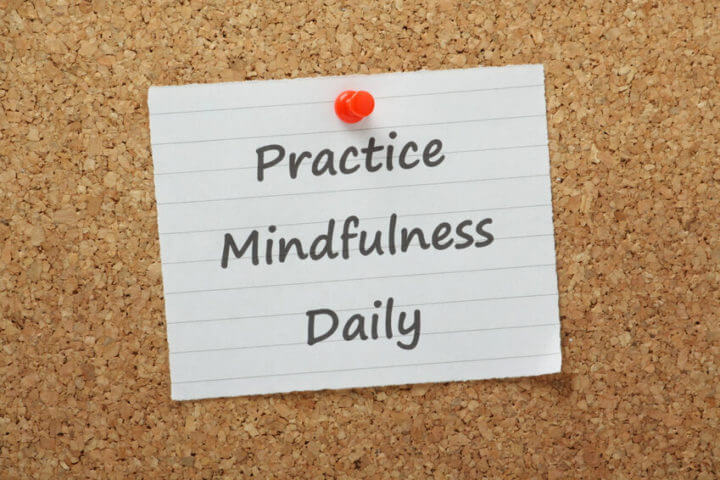“Mind how you go!” “Mind out for traffic!” “Mind what you eat!”
Have you ever stopped to think about what you really mean when you tell someone to mind out?
Expressing concern for someone to “mind” what they do roughly translates as: “Be careful! If you watch what you’re doing then nothing bad will happen!”
Telling someone to be “mindful” of their actions implies that there’s an underlying fear that can be avoided by paying attention. What you’re actually saying when you tell someone to be mindful is this:
Stop. Take in what’s going on around you and you’ll be safe from harm.
Although most of us don’t make this connection, it’s a powerful clue to as to why the practice of mindfulness is an incredibly effective way to allay anxiety, fear and worry. As stress is the number one cause of Adrenal Fatigue, there’s a really important lesson to be learned here.
The practice of mindfulness has the power to reduce the stress and anxiety of daily life and is an invaluable tool for anyone suffering from adrenal fatigue.
Modern Mindfulness – How does it work?
It’s easy to think that mindfulness is something which goes on in New Age workshops and is really only helpful if you’re into spirituality or meditation. Nothing could be further from the truth. Mindfulness is a simple practice that can be done anywhere, by anyone; and contrary to popular belief has nothing at all to do with religion or “finding yourself”.
You may be surprised to learn that employers around the globe are now using mindfulness techniques to help reduce employee stress and improve staff wellbeing.
- In the UK, London Transport offers mindfulness workshops to their employees in an attempt to combat work place stress. The scheme has proven to be such a roaring success, that almost all of the people who take part make significant changes to their lives as a result.
- Google has built an indoor labyrinth for mindful walking and holds regular “mindful” lunches in the interest of staff health.
- Many major banking chains including Goldman Sachs and Morgan Stanley have invested significant amounts of money into making mindfulness accessible to their employees.
When top companies like these are ploughing such large amounts of cash into making mindfulness part of the working day, you have to agree there has to be something in it.
What is Mindfulness?
Most of us are juggling busy lives and so multi-tasking has become the norm.
Do you recognise any of these situations?
- You’re driving to work wondering what to cook for dinner. Before you know it you’ve arrived at your destination yet remember nothing at all about your journey.
- Your job has become so routine that it’s now second nature. Rather than learn new skills, you mechanically perform your tasks on auto-pilot without really thinking about what you’re doing.
- You hear a dreadful story on the news, yet you accept it as having happened without really questioning it.
All of the above are examples of what you might call “mindless-ness” i.e. not being present in the moment. Most of us don’t even realise we’re doing it because the fact is, we’re unaware or “not there” to notice. Our thoughts are so full of the things that we need to do and the places we need to be that there’s no time for stillness or peace in our day.
Mindfulness is the opposite of this. It’s about being fully present in the here and now; taking time out to listen to the sounds around you, tasting the food that you put into your mouth, being aware of your surroundings…
There’s considerable evidence to suggest that mindfulness relieves stress. It can also be helpful for many other mental health issues such as depression and anxiety. An easy way to experience mindfulness for yourself is to sit quietly for 5 minutes and focus on your breath. This simple act brings you into the present. It reminds you that you are breathing right now, not at some point in the future or in the past, but at this very moment.
When you’re focused on what you’re doing in the here and now, it’s hard to be worried about what might happen at the weekend or to dwell on issues that haven’t been resolved in the past. It reminds you of your present surroundings, and takes you away from any thoughts of other places, people and events.
Although mindfulness won’t eliminate your problems, it can certainly provide perspective; making it an invaluable tool for anyone with adrenal fatigue.
How to make Mindfulness part of your stress reduction plan.
Mindfulness can be done anywhere, any time. Here are a few top tips for finding space for mindfulness practice, even when you’re having a hectic day:
Eat mindfully
Food plays a huge part in helping to heal adrenal fatigue. However, what good is that scrumptiously healthy lunch you’ve prepared if you’re just going to chow it down whilst sitting at your desk?
Far too few people actually taste their food, either because they eat in a hurry or their mind is elsewhere. When you take the time to chew and savour your food, you become more aware of when you’re full, making it easier to know when to stop eating. By paying attention to your body while you eat, you’ll begin to learn the difference between being truly hungry and eating for eating’s sake. This can help you make better food choices; both for your pocket, and your health.
Shop mindfully
Have you ever found yourself walking around the store grabbing the same old products without really thinking about what you’re buying? A far better way to shop is to practice what you might call ‘mindful browsing’. Touch the products; feel the packaging; read the labels; think about the foods you put into your basket, and what they can do for your energy levels. Choosing to be present while you shop can take the stress out of the weekly shopping trip as well as paying dividends for your adrenal health.
Mindful rest
How many times have you stayed late at work despite the fact you’re dog tired and crying out for rest? In a mind-less state, you’re far more likely to ignore the signals your body is sending. Over-riding that tired, burned out feeling and carrying on regardless is just asking for trouble. In fact, for many people with adrenal fatigue, that’s how they got ill in the first place. Paying attention to how you feel is a key element of mindful practice. I know it’s a cliché, but listening to your body should be top of mind when you’re adrenals are exhausted.
Take-away
Practicing mindfulness doesn’t have to be an “extra” thing you have to fit into your schedule. You can do it while eating lunch, standing in a bus queue or even while getting dressed. You don’t have to go on a course or read the research to benefit.
Re-training your brain to slow down and take note does take some mental effort at first. However, just five minutes of mindful action each day can bring about huge benefits. Try it for yourself and see!
Tell us about your mindful moments and share your tips in the comments below!




Leave a Reply